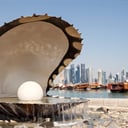What form of architecture uses the flying buttress?
The flying buttress developed in the Gothic period (12th–16th century) of architecture. It evolved in the Gothic era from earlier simpler, hidden supports. The design increased the supporting power of the buttress and allowed for the creation of churches with high ceilings, which is typical of Gothic architecture.
The defining, functional characteristic of a flying buttress is that it is not in contact with the wall it supports, like a traditional buttress, and so transmits the lateral forces across the span of intervening space between the wall and the pier. To provide lateral support, flying-buttress systems are composed of two parts: (i) a massive pier, a vertical block of masonry situated away from the building wall, and (ii) an arch that bridges the span between the pier and the wall. Either a segmental arch or a quadrant arch is used as the flyer of the flying buttress.
More Info:
ic.galegroup.com









